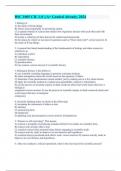Exam (elaborations)
BSC 1005 CH. 1-8 || A+ Graded Already || 2024
- Course
- Institution
1. Biology is: A) the study of living things. B) always used responsibly in advertising claims. C) a separate branch of science that studies how organisms interact with each other and with their environment. D) mostly a collection of facts that can be ordered and memorized. E) the means by whi...
[Show more]



